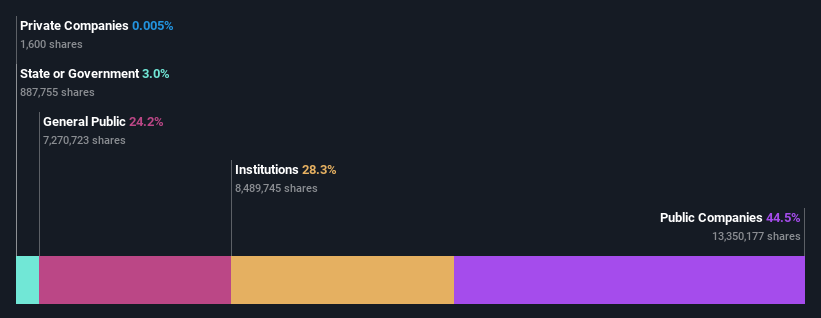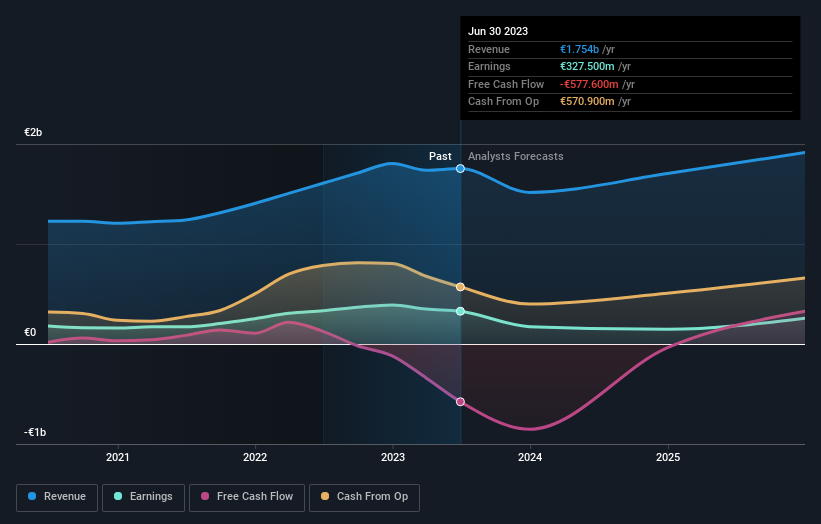Public companies account for 45% of Siltronic AG's (ETR:WAF) ownership, while institutions account for 28%
Key Insights
The considerable ownership by public companies in Siltronic indicates that they collectively have a greater say in management and business strategy
The top 4 shareholders own 51% of the company
A look at the shareholders of Siltronic AG (ETR:WAF) can tell us which group is most powerful. And the group that holds the biggest piece of the pie are public companies with 45% ownership. Put another way, the group faces the maximum upside potential (or downside risk).
Institutions, on the other hand, account for 28% of the company's stockholders. Insiders often own a large chunk of younger, smaller, companies while huge companies tend to have institutions as shareholders.
Let's delve deeper into each type of owner of Siltronic, beginning with the chart below.
See our latest analysis for Siltronic
What Does The Institutional Ownership Tell Us About Siltronic?
Institutional investors commonly compare their own returns to the returns of a commonly followed index. So they generally do consider buying larger companies that are included in the relevant benchmark index.
We can see that Siltronic does have institutional investors; and they hold a good portion of the company's stock. This can indicate that the company has a certain degree of credibility in the investment community. However, it is best to be wary of relying on the supposed validation that comes with institutional investors. They too, get it wrong sometimes. If multiple institutions change their view on a stock at the same time, you could see the share price drop fast. It's therefore worth looking at Siltronic's earnings history below. Of course, the future is what really matters.
We note that hedge funds don't have a meaningful investment in Siltronic. Wacker Chemie AG is currently the largest shareholder, with 31% of shares outstanding. Sino-American Silicon Products Inc. is the second largest shareholder owning 14% of common stock, and Norges Bank Investment Management holds about 3.2% of the company stock.
To make our study more interesting, we found that the top 4 shareholders control more than half of the company which implies that this group has considerable sway over the company's decision-making.
While studying institutional ownership for a company can add value to your research, it is also a good practice to research analyst recommendations to get a deeper understand of a stock's expected performance. There are a reasonable number of analysts covering the stock, so it might be useful to find out their aggregate view on the future.
Insider Ownership Of Siltronic
While the precise definition of an insider can be subjective, almost everyone considers board members to be insiders. Company management run the business, but the CEO will answer to the board, even if he or she is a member of it.
I generally consider insider ownership to be a good thing. However, on some occasions it makes it more difficult for other shareholders to hold the board accountable for decisions.
We note our data does not show any board members holding shares, personally. It is unusual not to have at least some personal holdings by board members, so our data might be flawed. A good next step would be to check how much the CEO is paid.
General Public Ownership
With a 24% ownership, the general public, mostly comprising of individual investors, have some degree of sway over Siltronic. While this size of ownership may not be enough to sway a policy decision in their favour, they can still make a collective impact on company policies.
Public Company Ownership
It appears to us that public companies own 45% of Siltronic. This may be a strategic interest and the two companies may have related business interests. It could be that they have de-merged. This holding is probably worth investigating further.
Next Steps:
It's always worth thinking about the different groups who own shares in a company. But to understand Siltronic better, we need to consider many other factors. Be aware that Siltronic is showing 3 warning signs in our investment analysis , and 2 of those don't sit too well with us...
But ultimately it is the future, not the past, that will determine how well the owners of this business will do. Therefore we think it advisable to take a look at this free report showing whether analysts are predicting a brighter future.
NB: Figures in this article are calculated using data from the last twelve months, which refer to the 12-month period ending on the last date of the month the financial statement is dated. This may not be consistent with full year annual report figures.
Have feedback on this article? Concerned about the content? Get in touch with us directly. Alternatively, email editorial-team (at) simplywallst.com.
This article by Simply Wall St is general in nature. We provide commentary based on historical data and analyst forecasts only using an unbiased methodology and our articles are not intended to be financial advice. It does not constitute a recommendation to buy or sell any stock, and does not take account of your objectives, or your financial situation. We aim to bring you long-term focused analysis driven by fundamental data. Note that our analysis may not factor in the latest price-sensitive company announcements or qualitative material. Simply Wall St has no position in any stocks mentioned.


